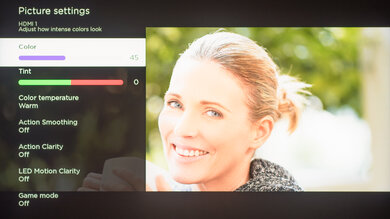We used the following calibration settings to review the TCL 85" R745 (85R745) which is the only size available for this TV. These settings should apply to most types of content, except for gaming or use as a PC monitor, which require a few additional changes, listed below.
General Settings
Eco Settings
One of the first things we did was disable all of the Auto Power Savings options, as we don't want the TV to adjust the image during testing.
SDR
For SDR content, there are six preset picture modes. We recommend choosing the 'Movie' Picture Mode, as it's the most accurate one out of the box, and allows for the most customization. From the Picture Settings menu, we recommend setting Contrast to '100', Brightness to '50', and Sharpness to '0'. We also set Color to '45', and Tint (G/R) to '0'. Finally, we chose the 'Warm' Color Temperature.
To make the image brighter in SDR, you should first select the TV Brightness range to one of the five preset options (we recommended 'Brighter') and then adjust the Backlight in the Picture Settings depending on your specific viewing conditions. Changing this setting does not have any impact on the overall picture quality. The Brightness setting is a picture adjustment setting, and we do not recommend adjusting it.
The Local Contrast setting controls the R745's local dimming feature. We recommend the 'High' setting.
Image Enhancements
As we aim for an image that is as close as possible to the content creator's intent, we disable most image processing options, including Dynamic Contrast. You should adjust these to your personal preference, though.
HDR
HDR is automatically enabled for the native apps. When you start playing HDR content, a small HDR icon appears next to the picture mode on the quick settings menu. Once you start playing HDR content, some of the settings change automatically, including the Backlight. We recommend leaving these settings to their default settings in HDR and using the 'Dark HDR' Picture Mode.
For HDR to work from external devices, HDMI 2.0 usually has to be enabled from the HDMI menu for the input you are using. Older devices may have compatibility issues if this option is left enabled, so it's recommended to only enable this setting for devices that require it.
Dolby Vision
The TCL R745 QLED supports Dolby Vision from native apps and with most external devices. As with normal HDR content, when you start playing Dolby Vision content, some settings change automatically. We recommend leaving these settings as-is, do not copy our SDR settings over. You can also disable a setting that displays the Dolby Vision logo when it starts playing.
Motion Settings
Although we disable most motion enhancing functions for most of our tests, you should adjust these to whatever looks best for you. Some settings may need to be adjusted depending on the specific content you are watching.
Black Frame Insertion
The TCL R745 has an optional black frame insertion feature, known as LED Motion Clarity. Enabling it results in less persistence blur, but it may cause duplications in motion. It only flickers at 60Hz, and not 120Hz.
Motion Interpolation
The TCL R745 has an optional motion interpolation feature, which causes the effect known as the Soap Opera Effect. Adjust Action Smoothing to 'High' for 30fps content and Action Clarity to 'High' for 60fps content.
Judder Settings
The TCL R745 is able to remove judder from all sources, without you having to adjust any setting.
Gaming
This TV can enter Game Mode from any picture mode. When you start gaming, it should set Game Mode to 'On' to get the lowest possible input lag. Continue using the recommended settings for SDR or HDR. For HDR gaming, it's important to make sure that HDMI 2.0 is enabled for the input you are using. There's also a 'Gaming' Picture Mode that you can use to get the lowest input lag possible, but the image may look different.
When connected to supported gaming devices, including the Xbox One, the R745 will automatically enter Game Mode when it detects a game is running, and it leaves Game Mode when the game stops. This is known as Auto Low Latency Mode (ALLM).
This TV also supports variable refresh rate (VRR). To enable it, simply turn on Variable Refresh Rate.
PC Gaming
The R745 will automatically detect when it's connected to a PC, and will automatically enter PC Mode, and you can't change it. If it doesn't detect your PC, simply change the input icon to 'Computer'.
How To Access Calibration Settings
Some settings are only available via the Roku app, which you can download through the app stores on Android and iOS. On the Picture Settings page, there are a few settings that you can adjust from both the TV and the app, such as the Picture Mode and Color Temperature, but Gamma and Noise Reduction are only available through the app. Gamma affects the brightness of images, and we normally set it at '2.2', but if you find it too dark, set it to a lower number, and if it's too bright, set it higher. Noise Reduction aims to improve the gradients at the cost of losing fine details, but we've noticed it doesn't do much on TCL TVs. You also have to calibrate the TV through the app by setting Color Space to 'Custom' and adjusting the 11 Pt WB values.
White Balance Settings
The following are the results of the white balance and colorspace calibration on our unit. They are provided for reference, and should not be copied as the calibration values vary per individual unit even for the same model and same size as the TV we reviewed due to manufacturing tolerances. If you want to try them you will need to enter all values shown, as all of them are active at the same time. If you end up with worse picture quality, simply reset them to the default values.



























































